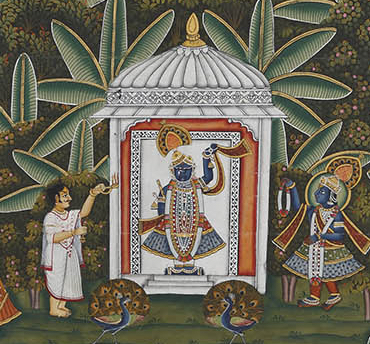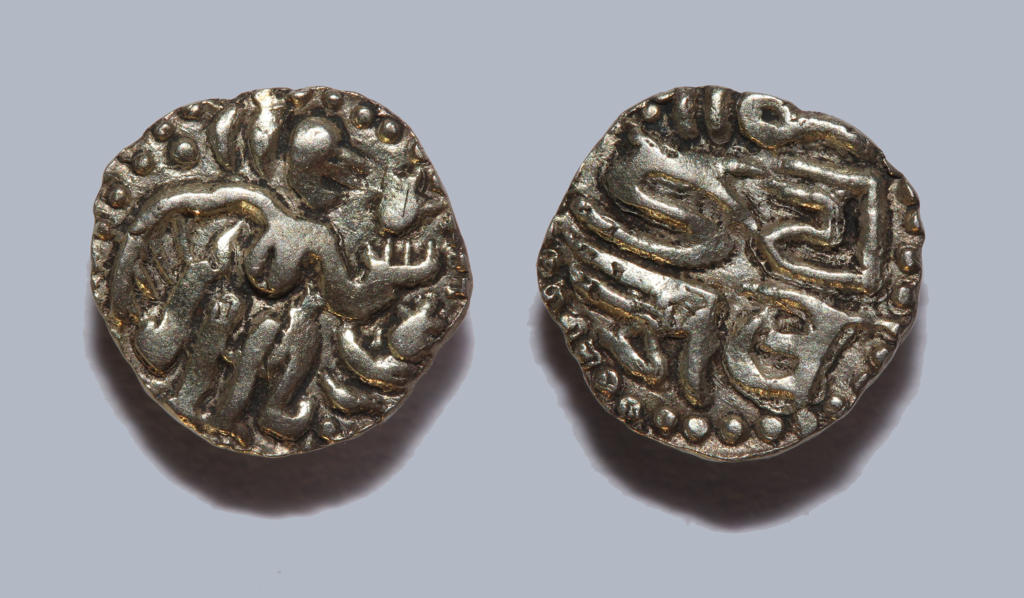
Silver fanam issued by Rajaraja Chola I © Sarmaya Arts Foundation
A thousand years ago, a powerful empire by the name of Chola extended its dominion across the Subcontinent and over islands of the Indian Ocean, from the Maldives to the Malayan peninsula. It gave its name to the Coromandel coast; Coromandel being an anglicisation of Cholamandalam or ‘the land of the Cholas’. The Imperial Cholas were a force to reckon with from the 9th to the 13th century CE as they reigned supreme over the land and high seas of South Asia.
The journey of the Cholas from being an obscure, if privileged, local clan confined to the river-banks of the Kaveri to attaining the exalted status they eventually did, began with the dynasty called Vijayalaya Cholas and their capture of Thanjavur in 850 CE. With their unmatched naval and militaristic supremacy, they went on to conquer islands across the Indian Ocean and establish settler colonies throughout South-East Asia. Wielding power from the Kaveri delta through their robust agricultural settlements, the Cholas monopolised trade routes between the western world and the Far East.
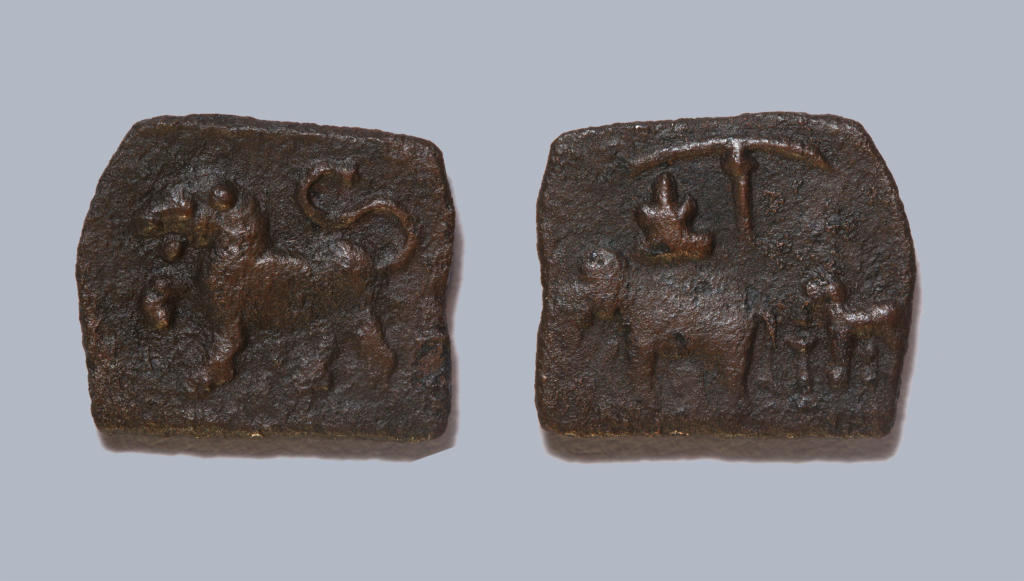
Chola-era copper coin © Sarmaya Arts Foundation
Due to this strategic geo-political positioning, the Chola coffers flourished and fuelled a Tamil cultural Renaissance of sorts. The wealth, resources and valuable spices flowing from the vast empire and trade went a long way in establishing the rich cultural legacy of the empire that still thrives in and around Tamil-speaking regions. Not unlike the Medicis of Florence, the Cholas at the height of their influence patronised all manner of visual, literary, architectural and culinary arts, in essence imprinting their larger-than-life personalities on every realm the royal treasury enriched.
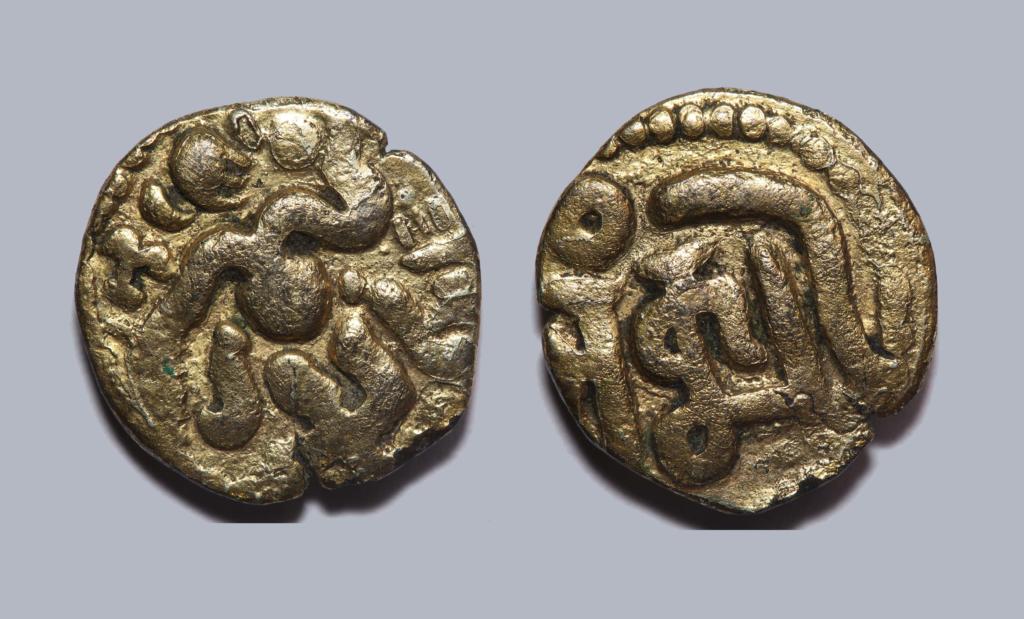
Chola-era coin minted in Ceylon (Sri Lanka) © Sarmaya Arts Foundation
Dr Janardhana B, assistant history professor at Indira Gandhi National Tribal University, noted in his paper on the Cholas: “The standards established in society, religion and fine arts during this period were regarded as classical and came to dominate the patterns of the living in the south and also influenced and modified at certain levels in the patterns existing elsewhere in Peninsula.”[1]
King of Kings
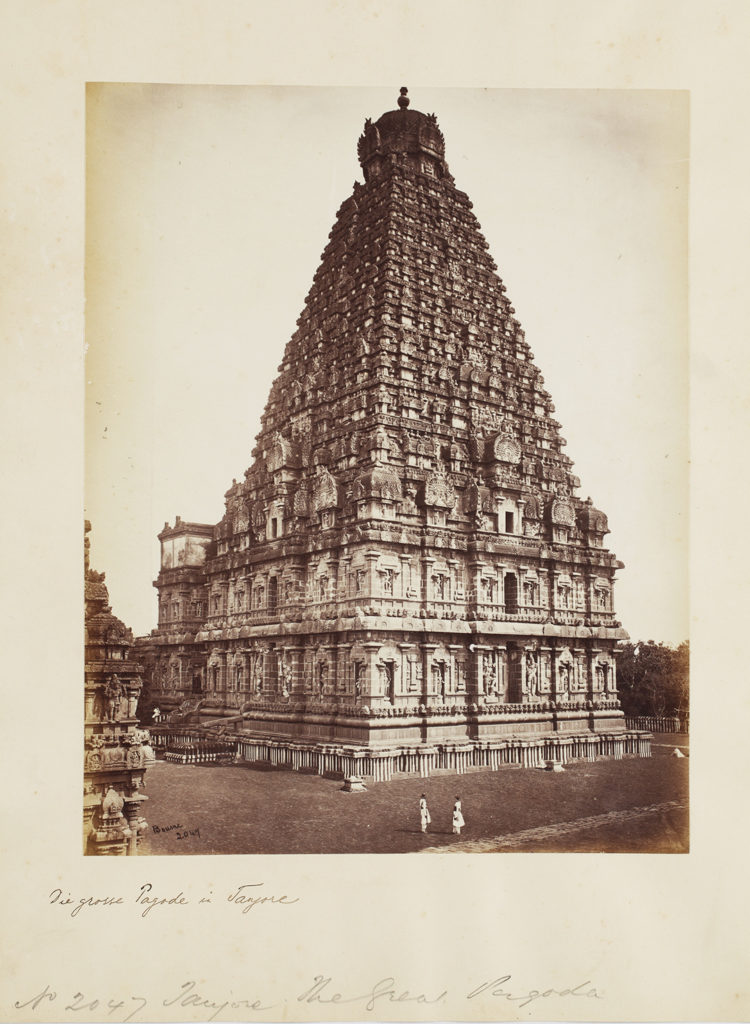
Brihadeshwara Temple, Tanjore © Sarmaya Arts Foundation
While the Cholas were documented to be in existence in the 3rd Century BCE per the inscriptions[2] of Mauryan King Ashoka, it’s only from the 8th and 9th century CE onwards that there’s evidence of the Cholas actually starting to consolidate power in south India. King Vijayalaya, taking advantage of the rift between the Pandyas and the Pallavas, rose to usurp power in the region in 850 CE, beginning a long run of prosperity for the dynasty. But it was really Rajaraja Chola I (reigned c. 985-1014 CE) who secured immortality for the Chola name.
With his successful foray into Ceylon (present-day Sri Lanka) and capture of the Maldives and Lakshadweep islands, his generous patronage of the arts, and astute administration of the kingdom, the empire prospered to create conditions for an economically, socially and culturally elevated society. It was Rajaraja who built the great Brihadeeswara Temple on the south bank of the Kaveri in the Chola capital of Thanjavur[3]. Dedicated to the Shaivite, Vaishnavite and Shakti traditions of the Hindu faith, it houses even today, a thousand years after its founding, one of the largest Shiva lingas in India and standing resolute over it, an incomparable superstructure of a granite vimana, the tower over the sanctum. A testament to the evolved craftsmanship of that era.
Page-turners & blockbusters
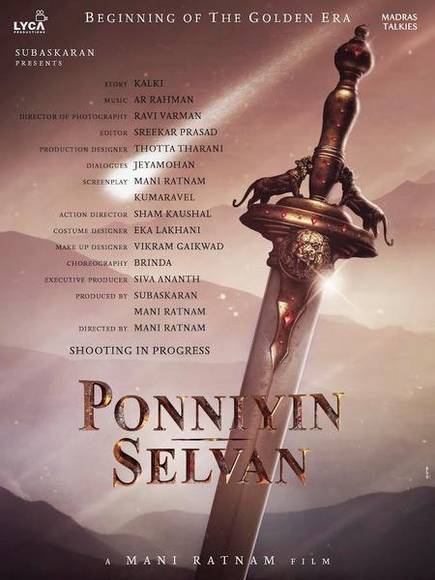
Poster for the Tamil film ‘Ponniyin Selvan’ based on the life of Rajaraja Chola I
The legend of Rajaraja’s rule continues to capture public imagination, particularly in Tamil literature and cinema. Regarded by many to be the greatest novel ever written in Tamil literature[4], Ponniyin Selvan is a piece of historical fiction by Kalki Krishnamurthy, based on the life of the dynasty’s most beloved ruler. Filled with details on the power struggles and intrigues in Rajaraja’s court, the story has been rendered in film and on TV many times. Ponniyin Selvan (Tamil for son of Ponni aka the Kaveri river) is now being produced as a motion picture by Mani Ratnam, with a superstar ensemble, an eye-popping budget of Rs 500 crore and a release date in 2022.[5]
Another celebrated work of Tamil literature from the Chola era is the poet Kamban’s rendition of the Ramayana, Ramavataram, written in 9th Century CE. Twentieth-century Tamil revolutionary VVS Aiyar said, “…in the Ramayana of Kamban, the world possesses an epic which can challenge comparison not merely with the Iliad and the Aenid, the Paradise Lost and the Mahabharata but with its original itself, namely the Ramayana of Valmiki.”[6] Kamban in his Ramayana portrayed Rama as a man who was elevated to the stature of god by his idealism. Despite Kamban himself proclaiming his Ramavataram to be a humble rendition of the Valmiki’s works, generations of readers consider it a masterpiece in in its own right.[7] Kamban’s name was evoked most recently in debates against the positioning of Hindi over other Indian languages that boast equally deep, if not deeper, cultural roots.
Towering temples
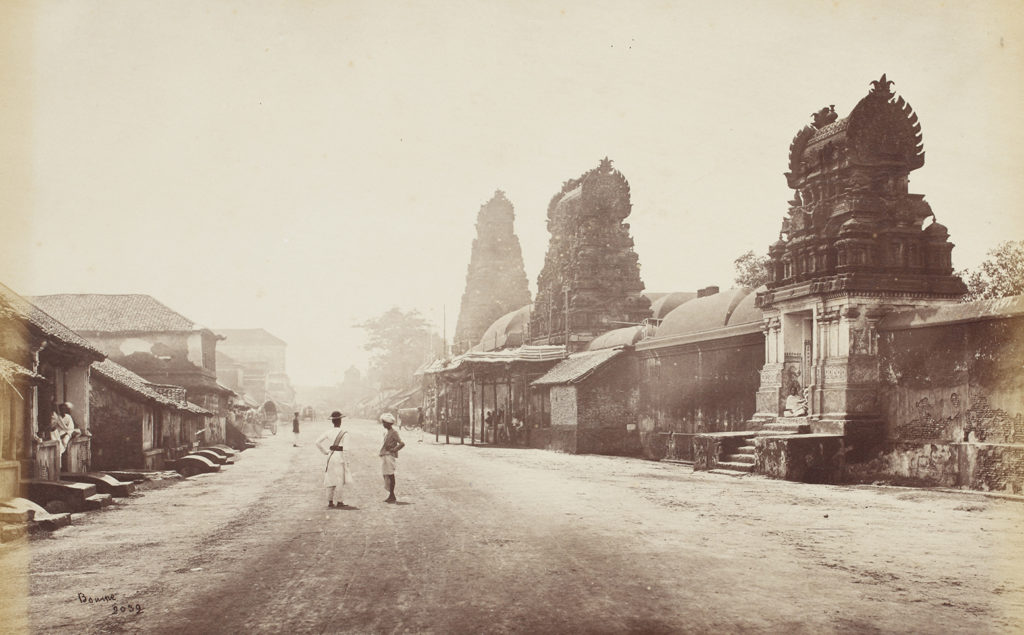
Street Scene, Tanjore © Sarmaya Arts Foundation
With the influx of income from agricultural and tolls from the monopoly on oceanic trade routes, the Cholas were flush with wealth to invest in the fortification of their own rule. They built temples of stone, massive edifices sculpted with no tools more complex than hammer and chisel. The Great Living Chola Temples along with several others, showcased the evolution of the grand arts of Dravidian temple architecture, sculpture, painting and bronze casting that blossomed during the Chola reign.
According to historian and author of Thanjavur: A Cultural History[8] Pradeep Chakravarthy though, the function of the temples then was same as what we expect of our government today—temples were responsible for seeing to the administration of a region. “Temples have so far been looked at as religious monuments, I’m going to look at them as political institutions. Everything that you expect from the government today was provided by the temple for the local community – they provided hospitals, educational institutions, employment opportunities, art and culture and collected taxes.”[9] This worked well for the faith since religious property would receive protection from the king and it worked well for the ruler because validation from a spiritual source legitimised their rule. “The Cholas used faith very carefully to rule.”
As the wealth and dominance of the Cholas increased through their unmatched militaristic and naval strength, grander temples were built and even grander rituals were designed to match the lifestyles and palaces of the ruler himself. With the flourishing of temples, temple towns boomed with all manner of artists and artisans. Craftspeople and artists were an integral part of the Chola empire-building enterprise. [10]
Bronzed gods
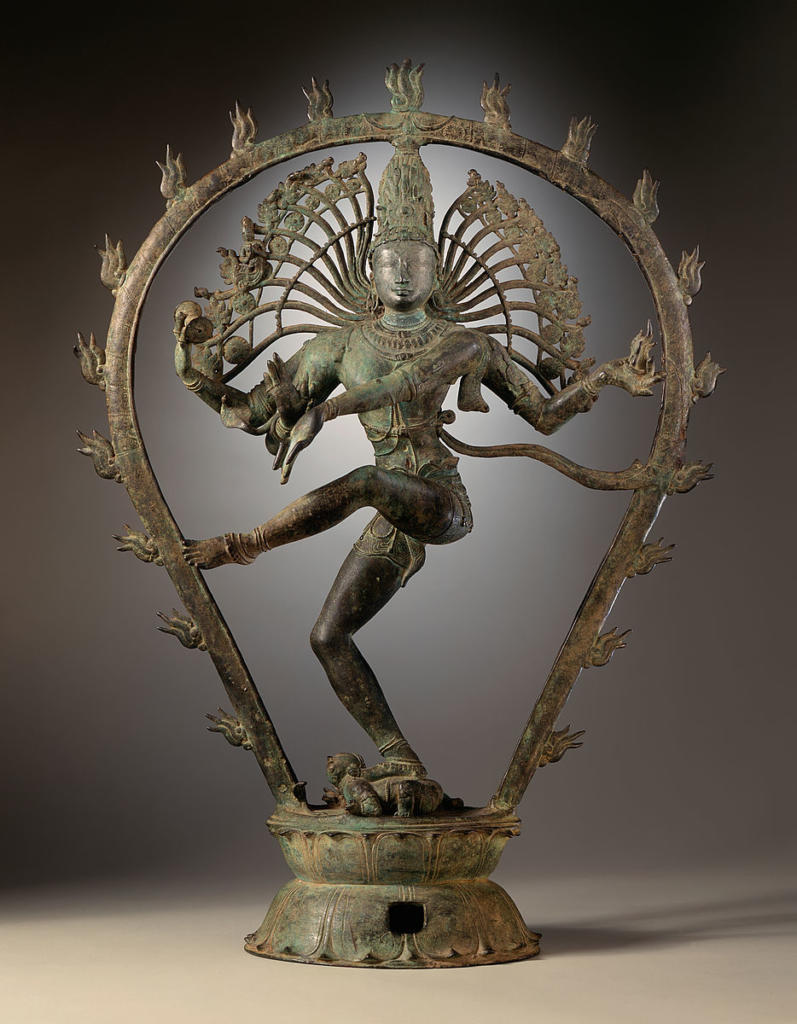
Nataraja or Shiva as the Lord of Dance, Chola-era bronze, courtesy LACMA/Wikipedia Creative Commons
While bronze casting has a long history in south India, specifically during Pallava rule, it reached its zenith during the Chola reign. Temple bronzes produced during the Chola dynasty are believed to be among the most spectacular works of art ever created in South Asia. They owe their birth to changing religious notions during 10th Century CE that required Hindu deities to participate in a variety of public roles, just like the monarch would. [11] Since the inner sanctum of a temple remained immovable, large bronze idols, called utsava murtis, were created to be carried during rituals, processions and festivals. [12] The round lugs and holes found on the bases of many of these sculptures were meant to accommodate the poles that carried them.[13]
Chola period bronzes were created using the ancient lost-wax technique.[14] The wax models used to cast the statues are lost to time, making each piece the only one of its kind. The well-known dancing figure of Shiva as Nataraja evolved and fully developed during the Chola period. Chola bronzes can be found in the Thanjavur Maratha Palace, the Government Museum in Chennai, the British Museum and New York’s Metropolitan Museum of Art. It is said that even the celebrated French sculptor, Auguste Rodin, took inspiration from the Chola bronzes – extolling the 11th century Chola Nataraja as “une chose divinement reglee” or something divinely decreed.[15]Pioneering historian of Indian art, JC Harle held that “early Chola bronzes represent the finest representations of godhood, unsurpassed in any place or age.”[16]
Rustling gold
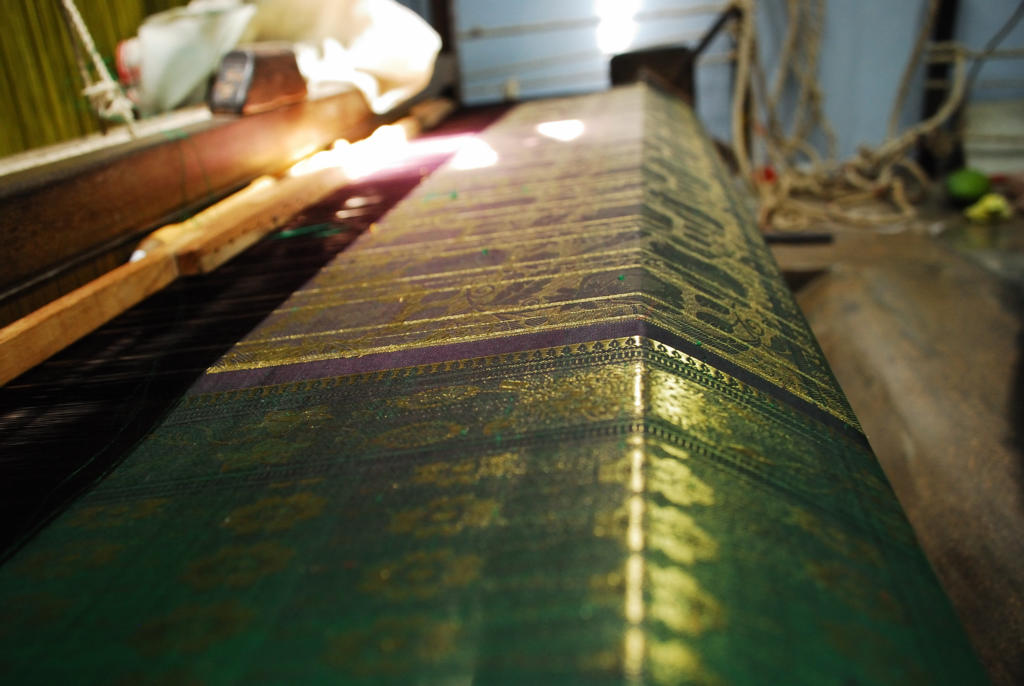
Kanjeevaram being woven at Kanchipuram, image courtesy C/N N/G/Flickr/CC BY-NC-SA 2.0
Chola kings provided a favourable atmosphere for artistic creativity and a distinctive direction in style. We can trace the origin of the highly coveted Kanjeevaram silk sarees to the time Rajaraja Chola invited weavers from Saurashtra, Gujarat to migrate to Kanchipuram.[17] Handloom silks woven with gold threads are used even today to adorn various temple idols. The beautiful motifs seen on the borders of Kanjeevarams are often inspired by ancient Chola iconography. The patterns on the temple walls and columns of Kanchipuram are mirrored in its weaves, making it an auspicious choice for brides.
After ruling the zeitgeist for generations, the Chola empire dwindled over the course of 12th Century CE. By 1279, Rajendra Chola III had lost his throne to the Pandyas, marking the end of a phenomenal dynastic reign. One that transformed the very contours of a region, its people and even its gods.
References
[1] http://www.igntu.ac.in/eContent/IGNTU-eContent-372703791801-MA-AIHC-2-DrJanardhanaB-PoliticalHistoryofIndiafromC.300CEto1200CE-3.pdf
[2] Kosmin, Paul J. (2014). The Land of the Elephant Kings. Harvard University Press. p. 57. ISBN 9780674728820
[3] The Hindus: An Alternative History by Wendy Doniger p.347
[4] https://indianexpress.com/article/entertainment/tamil/jayaram-joins-mani-ratnam-ponniyin-selvan-5940783/
[5] Ibid
[6] Ibid
[7] https://tamizhportal.org/2019/01/personalities-kavichakravarthi-kamban/
[8] https://www.amazon.in/Books-Pradeep-Chakravarthy/s?rh=n%3A976389031%2Cp_27%3APradeep+Chakravarthy
[9] https://sarmaya.in/talks/temple-trails-tracing-the-architecture-of-the-chola-dynasty/
[10] Crafts and Craftsmen in the Chola Empire https://www.researchgate.net/publication/344323490_CRAFTS_AND_CRAFTSMEN_IN_THE_CHOLA_EMPIRE
[11] https://www.asiasocietymuseum.org/region_results.asp?RegionID=1&CountryID=1&ChapterID=7
[12] Ibid
[13] Ibid
[14] Wolpert p.158
[15] Auguste Rodin, ‘Sculpture Caivites de l’Inde: La Danse de Civa’, in Ars Asiatica 3 http://eprints.nias.res.in/1910/1/2006-Orientations-SharadaSrinivasan.pdf
[16] James Harle, The Art and Architecture of the Indian Subcontinent, 2nd edition, 1994, London.
[17] Rao, P.V.L. Narasimha (2008). Kanchipuram – Land of Legends, Saints & Temples. New Delhi: Readworthy Publications (P) Ltd. ISBN 978-93-5018-104-1.



